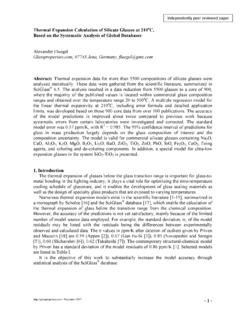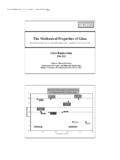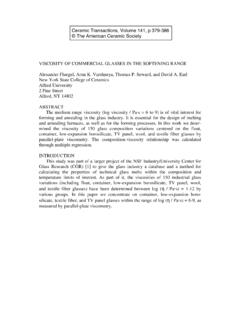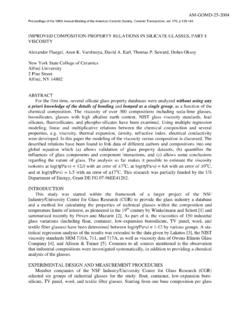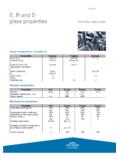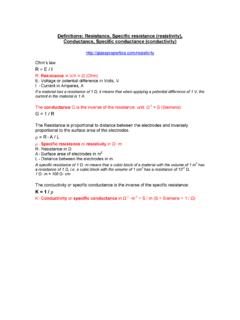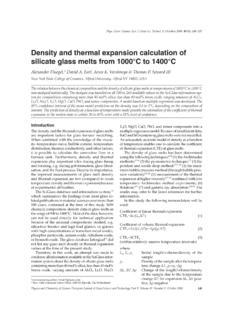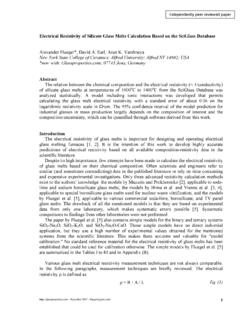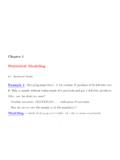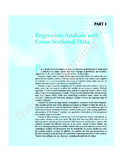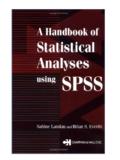Transcription of Statistical regression modelling of glass properties …
1 glass Technology: European Journal of glass Science and Technology Part A Volume 50 Number 1 February 2009 IntroductionIn glass research and technology, it is often neces-sary to reduce the costs of raw materials, to improve specific properties , or to design a glass composition for new applications. To meet these needs, the use of personal experience and published scientific literature is advantageous. In recent years, the crea-tion of large glass property databases has facilitated systematic glass property modelling and property measurement evaluation. It is no longer required to search worldwide for numerous individual publica-tions regarding specific properties .
2 The commercially available systems SciGlass(1) and Interglad(2) combine hundreds of thousands of experimental findings from the majority of glass research papers from over a cen-tury, including the associated references. In addition, SciGlass gives details about measurement methods. Furthermore, predictions are possible in SciGlass through models published previously, and Interglad includes a predictive linear regression the recent progress, there are several shortcomings in these commercial tools:(1) Numerous experimental data from various inves-tigators differ significantly, even within simple glass systems and for well investigated properties (see Figure 8 in the discussion of future work).
3 (2) Many predictive glass property models exist in the literature, and it is sometimes difficult to decide which model is the most appropriate.(3) Industrial glasses have complex compositions, and it is not always possible to predict properties through commonly used linear property compo-sition relations.(4) Some of the published models are based on sci-entific principles or derived assumptions about the details of chemical bonding within a glass . Therefore, experiments need to be interpreted (that lead to those scientific principles or to those derived assumptions about the details of chemi-cal bonding within a glass ) before some models can be established.
4 This can be a source of error based on the accuracy of this interpretation.(5) Some models consider the experimental find-ings of a few or only one single investigator, systematic errors of a few investigators easily can lead to incorrect conclusions. Systematic errors of whole data series are known in glass science as described below in Table 2, and referred to at the end of Step 7 of the Statistical analysis (outlier analysis, data leverage).(6) The prediction errors for models based on one investigator reflect the measurement precision in her/his laboratory, but it is not possible to conclude how such prediction errors will relate to those based on data from other this work, an attempt is made to overcome these problems above for practical application in glass technology.
5 The goal is a method that features quan-titative prediction accuracy and simplicity. Therefore, it is not a requirement to have an expert knowledge of all details of the nature of glass , the published modelling techniques, or advanced mathematical procedures. It is also not necessary to acquire expen-sive software (besides common spreadsheet software like Excel) or a high performance computer. However, it is strongly advised to rely on experience about the subject matter, and, if possible, on dedicated software that can perform some of the procedures described in this tutorial regression modelling of glass properties a tutorialAlexander FluegelPacific Northwest National Laboratory, Richland, WA 99352, USAM anuscript received 5 August 2005 Revised version received 14 July 2006 Accepted 28 July 2006 Known Statistical analysis methods are described in detail with the aim of developing a new and more accurate modelling approach for glass properties .
6 It is shown that the combined analysis of historic and current data from, for example, the SciGlass and Interglad databases, often provides the basis for making property predictions that are more reliable than the raw data itself or a few test measurements. Targeted glass research and process modelling can be facilitated by the approach at xxxxxxxx. Email XXXXXXXXXX@xxxxGlass Technol.: Eur. J. glass Sci. Technol. A, February 2009, 50 (1), xxx yyy glass Technology: European Journal of glass Science and Technology Part A Volume 50 Number 1 February 2009 High accuracy can be obtained by using (1) a large number of experimental findings from the commercial SciGlass and Interglad databases and (2) well established Statistical analysis techniques.
7 The Statistical approach outlined here is not original in general, as numerous publications can be consulted about the topic,(3 9) written over two centuries. In the current work, the Statistical method largely follows general techniques that are applied successfully, for example by Harold S Haller & Company(10) in busi-ness consulting, by Bechtel Hanford Inc. for nuclear waste vitrification,(11) and for modelling of solar con-trol glasses.(12) Statistical analysis is also firmly estab-lished in numerous areas in quality control, economy, biology, sociology, politics, etc., to mention just a few applications. The range of applications underlines the basic character of Statistical analysis that has been ignored for too long in glass analysis in glass science and technologyErnst Abbe, Otto Schott, and A.
8 Winkelmann initiated methodical studies of glass properties in the 19th century, creating the basis of modern glass science in Jena, Germany. They considerably improved the use of glasses for special applications, for optics, thermometers, and as a thermal shock resistant mate-rial. Winkelmann & Schott published the first model that allowed the prediction of glass properties based on the chemical composition, using the additivity principle,(13,14) multiple regression using linear functions. This principle is based on the assumption that the relation between the glass composition and a specific property is linearly related for all component concentrations.
9 In this case all of the component influences can be summed as followsPropertyii= += b b01 Cin (1)where 0 in Equation (1) is the model intercept, n is the total number of significant glass components exclud-ing the main component (usually silica), the i values are the individual numbers of the significant glass components, the i values are the component-specific coefficients, and the Ci values are the concentrations of the glass components (also called model factors or independent variables).The additivity principle allows for very precise and accurate predictions within limited concentration ranges,(12,13,15 24) that cannot be reached by structural,(25 29) thermodynamic,(30 53) or molecular dynamic(54 56) modelling approaches.
10 Because of the simplicity of the technique, the ease of interpretation, and good prediction results within specified limits, Equation (1) is most widely used for glass property modelling . The additivity principle cannot however be applied for modelling glass properties over wide concentration ranges because of component glass models summarised above are not dif-ferent in principle. Procedures expressed through equations based on specific variables are always established for property composition relationships. The variables and equations vary, however, and sometimes the variables are derived beforehand from basic principles ( ab initio ) which are in turn based on other (basic) observations such as the atomic mass, bonding distance, bond strength, electron af-finity, stochiometry, or elemental charge.
